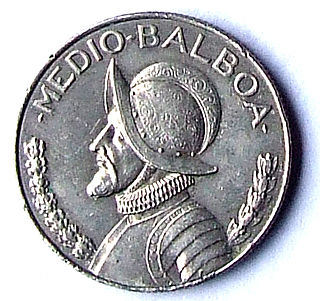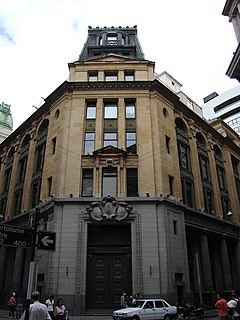
The balboa is, along with the United States dollar, one of the official currencies of Panama. It is named in honor of the Spanish explorer/conquistador Vasco Núñez de Balboa. The balboa is subdivided into 100 centésimos.
Banco Nacional Ultramarino was a Portuguese bank with operations throughout the world, especially in Portugal's former overseas provinces. It ceased existence as an independent legal entity in Portugal following its merger in 2001 with Caixa Geral de Depósitos, the government-owned savings bank.

BankBoston was a bank based in Boston, Massachusetts, which was created by the 1996 merger of Bank of Boston and BayBank. One of its predecessor banks started in 1784, but the merged BankBoston was short-lived, being acquired by Fleet Bank in 1999. In 2005, FleetBoston was purchased by, and merged into, Bank of America of Charlotte, North Carolina.
The colón was the currency of El Salvador from 1892 until 2001, when it was replaced by the U.S. dollar during the presidency of Francisco Flores. The colón was subdivided into 100 centavos and its ISO 4217 code was SVC. The plural is "colones" in Spanish and the currency was named after Christopher Columbus, known as Cristóbal Colón in Spanish.

Banco Santander, S.A., doing business as Santander Group, is a Spanish multinational financial services company based in Madrid and Santander in Spain. Additionally, Santander maintains a presence in all global financial centres as the 16th-largest banking institution in the world. Although known for its European banking operations, it has extended operations across North and South America, and more recently in continental Asia. It is considered a systemically important bank by Financial Stability Board.
HSBC México, S.A., the principal operating company of Grupo Financiero HSBC, S.A. de C.V., is one of Mexico’s four largest banking and financial service companies, with 1,400 branches and 5,200 ATMs. HSBC purchased Banco Internacional, S.A. known as Bital, in November 2002, several years after Bital participated in the controversial Fobaproa, which rescued the nation's banks from the 1994 crisis, at the cost of the Mexican taxpayers.
The peso was the currency of El Salvador between 1877 and 1919.
Grupo Banistmo was a Panamanian financial services company, and the largest in Central America. It was founded in 1984. In 1999 it began an expansion strategy that has resulted in the acquisition of banks in several Central American countries, as well as Colombia and the Bahamas. It was the holding company of Primer Banco del Istmo, S.A. or Banistmo, the largest bank in Panama. Its President and Chief Executive Officer was Alberto Vallarino. In November 2006 it was acquired by HSBC Holdings plc, and merged with HSBC Bank (Panama) S.A., the bank’s existing subsidiary in 2007. In 2013 Bancolombia Group acquired HSBC Panama and renamed it Banistmo.

Grupo Aval is a Colombian holding company engaged in a wide variety of financial activities, including banking, telecommunications and real estate; in Colombia and Central America. Grupo Aval is controlled by Luis Carlos Sarmiento, who indirectly owns around 80 percent of its shares.
Itaú CorpBanca is the fourth largest commercial bank in Chile, the bank is owned by Itaú Unibanco (36%), the largest bank in Latin America by assets and CorpGroup (30%), a Chilean financial holding. Currently the bank has 398 bank branches in Chile and Colombia, being 224 in Chile and 174 in Colombia. Itaú Corpbanca is headquartered in Santiago and has offices in Lima, Madrid and New York City.

Davivienda is a Colombian bank founded on August 1, 1972, which renders services to individuals, companies, and the rural sector. Currently, it is part of Grupo Bolivar and it is the third-largest bank in Colombia by assets and profits.
HSBC Bank may refer to any one of the following principal local banks or divisions of the HSBC Group:
HSBC Bank (Panama) S.A. was a subsidiary of HSBC Holdings plc headquartered in Panama City, Panama. The bank provides Personal banking, Corporate banking and Treasury services to Panama. In 2013 Bancolombia Group acquired HSBC Panama and renamed it as Banistmo.

The Anglo-South American Bank was a British and Argentine bank established with the acquisition of the Anglo-Argentine Bank in 1900 by the Bank of Tarapacá and London. The new bank first took the name of Bank of Tarapacá and Argentina, which it changed in 1907 to Anglo-South American Bank.
Jaime Gilinski Bacal is a Colombian banker and real estate developer. Gilinski resides in London. According to Forbes, he is the second richest person in Colombia, with a net worth of US$3.6 billion as of 2020.
The Banco Pichincha is the largest private bank in Ecuador, by capitalization and by number of depositors. It is the primary bank of the Pichincha Group, a business group that includes the companies associated with the bank and businesses related to Fidel Egas Grijalva and his family, which include Diners Club of Ecuador, Picaval and Teleamazonas.

Banco Bilbao Vizcaya Argentaria, S.A., better known by its initialism BBVA, is a Spanish multinational financial services company based in Madrid and Bilbao, Spain. It is one of the largest financial institutions in the world, and is present mainly in Spain, South America, North America, Turkey, and Romania.

The economy of Central America is the eleventh-largest economy in Latin America, behind Brazil, Mexico, Argentina and Colombia. According to the World Bank, the nominal GDP of Central America reached 204 billion US dollar in 2010, as recovery from the crisis of 2009, where gross domestic product (GDP) suffered a decline to 3.8%. The major economic income are the agriculture and tourism, although the industrial sector is in strong growth, mainly in Panama.
María Eugenia Brizuela de Ávila is a Salvadoran lawyer who served as Minister of Foreign Affairs for the country from 1999 to 2004. She worked as a Director of Corporate Sustainability at HSBC for Latin America and is based in Mexico City.








